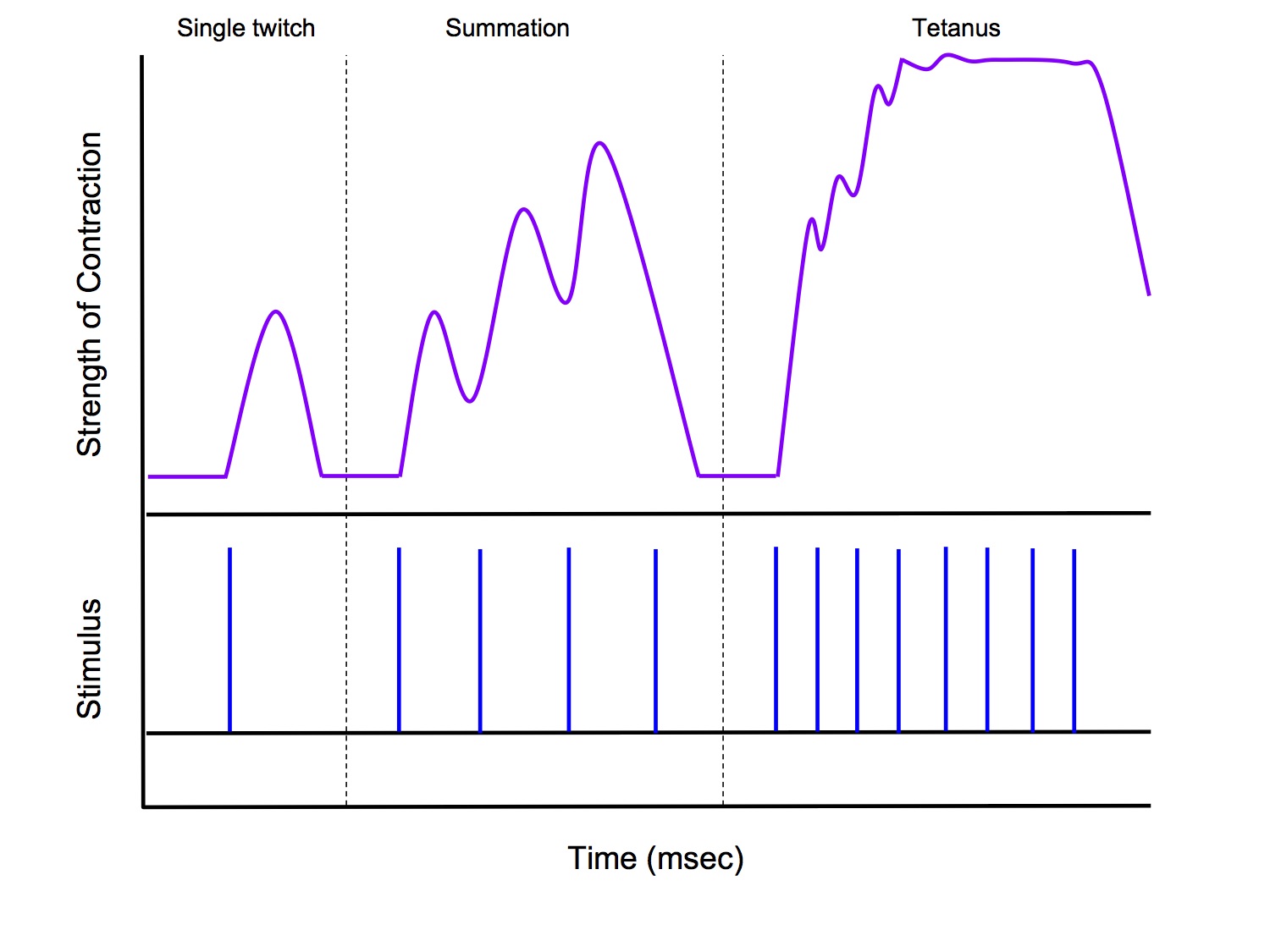Definitions
Tetanus
- A sustained muscle contraction without relaxation, resulting from high frequency stimulation of a muscle fibre
Summation / Treppe Effect
- The addition of a second twitch, leading to greater tension, resulting from stimulation of the muscle fibre before it has a chance to relax completely
Muscle Physiology
Excitation-Contraction Coupling
- Excitation-contraction coupling refers to the process by which the action potential in the muscle fibre causes the myofibrils to contract
- It is explained by the sliding filament theory
- I think it is low yield to try to remember all the details, I would simply remember that
- The sliding filament theory refers to a cycle of repetitive events that cause a thin filament (actin) to slide over a thick filament (myosin) and generate tension in the muscle
- It involves crossbridge cycling between myosin heads that drags it along the actin filament and is ATP dependent
- If you want to know more detail this wikipedia article is pretty decent
Sliding filament theory
- Muscle contraction involves thick and thin filament sliding along each other
- Action potential →
- release of Ca2+ from sarcoplasmic reticulum →
- Ca2+ interacts with troponin-C→
- tropomyosin conformational change →
- exposes actin binding site to myosin head →
- myosin head forms cross bridge with actin fibres →
- pulls towards centre of sarcomere →
- detachment from actin
- ATP is needed for each cycle of cross-bridging
- Termination of coupling when SR requesters Ca2+ → troponin-tropomyosin mediated inhibition between actin and myosin returns
- Minimum ATP stores in muscles
- Replenished by:
- ADP + creatine phosphate (catalysed by creatine phosphokinase) → ATP + creatine
- Glycolysis (using glycogen stores) replenishes creatine phosphate by reversing reaction above
- Anaerobic metabolism produces lactic acid and muscle pains
Length-tension relationship
- Need optimal overlap of actin and myosin for maximal tension
- Reduced tension if excessive shortening or stretching of muscle fibres
Summation / Treppe Effect & Tetanus

- The skeletal muscle action potential is relatively short compared to the slower mechanical response from muscle
- AP refractory period is over before contraction begins to fall
- Repeated stimuli occuring before complete relaxation of the muscle fibre results in summation (Treppe effect)
- If stimuli are at high frequency → smooth tetanus with tension maintained at high level
- On the other hand, the cardiac muscle action potential is longer and of similar duration to the mechanical contraction. Summation and tetanus cannot occur because the muscle remains in the refractory period until full relaxation has occured
Skeletal Muscle vs Cardiac Muscle
| Skeletal Muscle | Cardiac Muscle | |
|---|---|---|
| Structure | Fibres are 10-100um diameter. Each fibre is the length of the muscle | Network of branching fibres connected by intercalated discs (low resistance gap junctions), allowing for synchronised depolarisation. Called a functional syncytium |
| AP Duration | Short | Long |
| Summation / Tetanus Possible? | Yes | No |
| AP Spread | Fibres stimulated independently | AP spreads between muscle fibres via the gap junctions |
| Excitation-Contraction Coupling | Ca2+ released into cytoplasm from sarcoplasmic reticulum | Ca2+ enters cytoplasm from from SR and extracellular fluid |
| Pacemaker Activity | None. Cannot contract without nerve stimulation | Action potentials originate from pacemaker cells in heart |